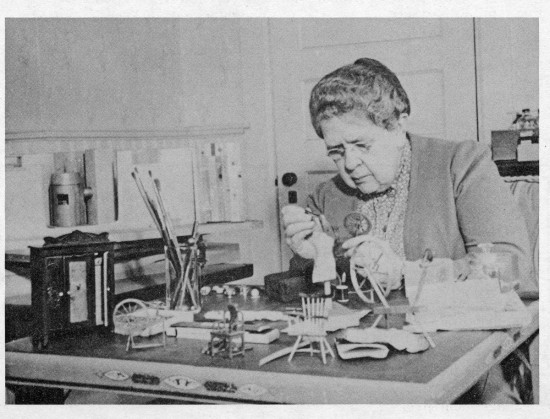Crime
Crime-Fighting Babies
Business owners in southeast London are decorating their store fronts with giant pictures of babies, in the hope that such pictures will deter criminals and rioters. [The Blaze]Maybe it's just me, but something looks odd about the baby in the picture. I think it's the hair. I know some babies are born with more hair than others, but that kid has such a full head of hair that he looks like he's wearing a wig. Also, (and I know this is not a comparison that would occur to most people) he vaguely reminds me of the (fake) baby Adolf Hitler.

Posted By: Alex - Sun Sep 09, 2012 -
Comments (5)
Category: Babies, Crime
The Method of the Nail

I came across an unusual article titled "The Good Old Method of the Nail" in an old medical journal. (Unfortunately I can't find an online version of it.) The article details the history of killing people by driving nails into their brain.
Apparently the 'method of the nail' used to be quite a popular homicide technique, because in the days before x-rays it was hard to tell that someone had a nail in their head. The victim's hair might hide the wound, so people, not seeing any obvious sign of injury or foul play, would often assume death occurred from natural causes.
The method of the nail is such an ancient technique that it's mentioned in the Bible, Book of Judges 4:21:
It also pops up in Chaucer's Canterbury Tales, in "The Wife of Bath's Prologue," which includes a list of various ways wives kill their husbands:
Whyl that they slepte, and thus they han
hem slayn.
Nor is the nail-in-the-head just a western phenomenon. It also has deep roots in Chinese culture. From the article:
The point of these stories is always the same: the judge is baffled by the fact that although there are strong reasons for suspecting the wife, the body of the husband shows no signs of violence. The final discovery of the nail is elaborated in various ways.
The oldest version said that Yen Tsun found it because he noted that a swarm of flies congregated on one place on top of the dead man's skull...
In 1881, Stent recorded another version under the title 'The Double Nail Murders' in volume 10 of the China Review: When the coroner fails to discover any trace of violence on the victim's corpse, his own wife suggests to him that he look for a nail. When the judge has convicted the murdered man's widow on this evidence, he also has the coroner's wife brought to him, since her knowledge of such a subtle way of committing a murder seems suspicious to him. It transpires that the coroner is her second husband. The corpse of her first husband is exhumed, and a nail discovered inside the skull. Both women are executed.
The image at the top is an x-ray from a 1973 case, in which a man used a hammer to drive an awl into his wife's head, explaining that he did it to "exorcise the evil soul that had taken its place in her head."
Posted By: Alex - Sat Sep 08, 2012 -
Comments (6)
Category: Crime, Brain, Brain Damage
The Nutshell Studies of Unexplained Deaths

Once upon a time, there was a kindly old lady who specialized in creating gruesome murder dioramas. Her name was Frances Glessner Lee, and her little scenes went on to educate criminologists for decades.

Follow the link for a whole book about her.
Posted By: Paul - Tue May 08, 2012 -
Comments (8)
Category: Crime, Death, Eccentrics, Education, Toys, 1940s, 1950s
The Art of John Wayne Gacy
WU readers are surely familiar with John Wayne Gacy, if only because his middle name is Wayne. Convicted of at least 33 murders. He liked to dress as Pogo the Clown at charity events. Executed in 1994. And (what I didn't know) is that he took up art while in prison. He liked to paint Disney characters, clowns, and skulls.According to Wikipedia: "Exhibitions of Gacy's artwork have been held since the 1980s and continue to be held. Gacy dismissed criticism that he was permitted to keep money from the sale of his paintings, claiming his artwork was intended 'to bring joy into people's lives'."


A prison guard displaying Gacy's painting (titled "Hi-Ho Hi-Ho")


Posted By: Alex - Wed Feb 01, 2012 -
Comments (6)
Category: Art, Clowns, Crime
12 year old stops robbery in Turkey
Before you put on a mask and try to rob a jewelry store, make sure this kid isn't standing close by.Hope he got a reward!!
Posted By: gdanea - Mon Oct 03, 2011 -
Comments (2)
Category: Crime
Black Money Cleaning
Look! A video! It must be real!
Black Money Scam.
Posted By: Paul - Sun Sep 04, 2011 -
Comments (2)
Category: Crime, Stupid Criminals, Hoaxes and Imposters and Imitators, Money, Baths, Showers and Other Cleansing Methods, Africa
Worst Theme Park Experience Ever


Click either image to enlarge.
More info here.
Posted By: Paul - Fri Feb 04, 2011 -
Comments (6)
Category: Crime, Fairs, Amusement Parks, and Resorts, 1950s
Weird Shorts – 4

That’s not to say that our massive consumption doesn’t have it’s upside, As Vangelis Kapatos of Manhattan discovered when he attempted suicide by jumping from his ninth floor flat, only to survive when his fall was broken by a pile of uncollected garbage. Mr. Kapatos’ timing, from his perspective, couldn’t have been worse, the unusually large garbage pile was due to collections being suspended because of snow. They were due to resume the day after his impromptu dumpster dive (Today Online).
Mind you, we’re not the only animals prone to excess. After finding the bodies of dozens of starlings near the city of Constanta in Romania, locals were concerned that the cause might be bird flu, instead post-mortems of the birds have revealed that they in fact died of alcohol poisoning, having ‘drunk’ themselves to death on the discarded leftovers of the local winemaking industry. A least they died happy (BBC News).
Better than dying happy, though, is living happy, and the secret of that, says the UK’s Office for National Statistics, is having a job. But it’s not the pay but the job security that counts, say the government statisticians, which ironically are facing staff cuts themselves due to the economic downturn. Other key happiness factors, according to the preliminary report, are good personal health and a decent family life. What will we do without these people (Telegraph)?
More in extended >>
Posted By: Dumbfounded - Thu Jan 13, 2011 -
Comments (4)
Category: Animals, Dinosaurs and Other Extinct Creatures, Armageddon and Apocalypses, Babies, Crime, Death, Human Marvels, Inebriation and Intoxicants, Religion, Sexuality, Weird Names, Body Fluids, Perfume and Cologne and Other Scents
Brazilian ATM Robbery
Subtle they ain't.....
Posted By: Paul - Sat Jan 08, 2011 -
Comments (4)
Category: Crime, South America
Branded!
This TV theme song and imagery has stuck with me since childhood. It's undeniably powerful still, I think.
But who knew that the armed forces today still do the same thing? Read about the Canadian response to the conviction of a twisted soldier.
Posted By: Paul - Sat Nov 20, 2010 -
Comments (6)
Category: Crime, Public Humiliation, Rituals and Superstitions, Television, 1960s, Armed Forces

| Who We Are |
|---|
| Alex Boese Alex is the creator and curator of the Museum of Hoaxes. He's also the author of various weird, non-fiction, science-themed books such as Elephants on Acid and Psychedelic Apes. Paul Di Filippo Paul has been paid to put weird ideas into fictional form for over thirty years, in his career as a noted science fiction writer. He has recently begun blogging on many curious topics with three fellow writers at The Inferior 4+1. Contact Us |




